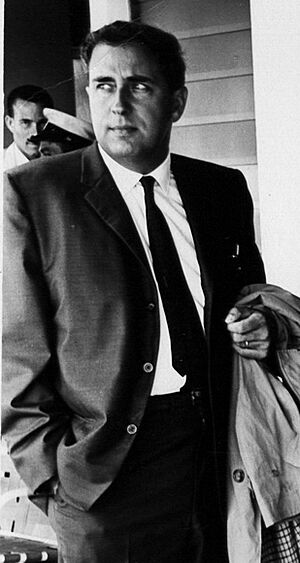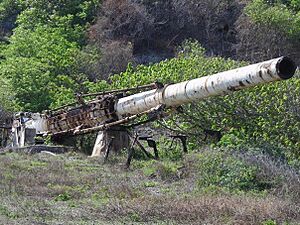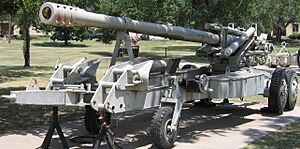Gerald Bull facts for kids
Quick facts for kids
Gerald Bull
|
|
|---|---|

Bull at the Space Research Institute of McGill University in 1964
|
|
| Born |
Gerald Vincent Bull
March 9, 1928 North Bay, Ontario, Canada
|
| Died | March 22, 1990 (aged 62) Uccle, Brussels, Belgium
|
| Alma mater | University of Toronto |
| Known for | Weapons development Project HARP Project Babylon |
| Spouse(s) | Noemi "Mimi" Gilbert (m. 1954) |
| Children | 10 |
| Scientific career | |
| Fields | Ballistics |
| Institutions | McGill University Canadian Armament and Research Development Establishment Space Research Corporation |
| Thesis | (1951) |
| Doctoral advisor | Gordon Patterson |
Gerald Vincent Bull (born March 9, 1928 – died March 22, 1990) was a Canadian engineer. He was famous for developing very long-range artillery (big guns). He dreamed of launching satellites into space using a giant "space gun" instead of expensive rockets.
To achieve this, he designed the "Supergun" for the government of Saddam Hussein in Iraq. Bull was killed outside his apartment in Brussels, Belgium, in March 1990. Many believe his assassination was carried out by the Mossad, Israel's intelligence agency, because of his work for Iraq. No one has ever been charged with his murder.
Contents
Early Life and Education
Gerald Vincent Bull was born in North Bay, Ontario, Canada. His father, George Bull, was a lawyer, and his mother, Gertrude, had 10 children. The family was well-off until the Wall Street Crash of 1929 and the Great Depression. This financial crisis changed their lives dramatically.
After his mother died when he was young, Gerald and his siblings were cared for by relatives. Gerald went to a Jesuit school called Regiopolis College in Kingston, Ontario. Even though he was very young, the school allowed him to start in 1938. During his summers, he enjoyed building balsa wood airplanes. He graduated from high school in 1944.
University Studies
After high school, Bull wanted to study engineering. He was accepted into the new aeronautical engineering program at the University of Toronto. Even though he was only 16, he was interviewed and accepted. He graduated in 1948.
Later that year, the University of Toronto opened a new Institute of Aerodynamics. Bull was accepted there and worked on building a supersonic wind tunnel. This was a rare device used to study how things fly at very high speeds. He used this work for his Master's thesis in 1949.
In 1950, Bull finished his PhD thesis on the same topic. At 23 years old, he became the youngest PhD graduate in the institute's history. This record still stands today. He then started working at the Canadian Armament and Research Development Establishment (CARDE).
Developing Big Guns
Work in Canada
CARDE was a research center in Canada that studied artillery and ballistics. Bull joined CARDE and wanted to build a wind tunnel. However, his ideas were too expensive. Instead, he was encouraged to fire models out of existing gun barrels to collect data. This was a much cheaper way to test designs.
They used a large gun barrel, bored out to 5.9 inches (150 mm). They fired scaled models of missiles through cards placed along a 1,000-yard range. This method allowed them to measure how fast the models flew and how they behaved in the air. Bull also developed a special system to put electronics inside the models. This allowed them to collect even more detailed information during flight.
In 1954, Bull married Noemi "Mimi" Gilbert. They had two sons, Phillippe and Michel. Bull also helped build a new wind tunnel at Laval University for only $6,000, using mostly scrap materials.
Bull's work gained public attention in 1955. A newspaper headline read, "Unveil Canadian Gun that Fires 4,550 M.P.H. Missiles." His research was very advanced for its time.
Later, Bull worked on improving gun performance using a "sabot." This is a special casing that holds a smaller projectile inside a larger gun barrel. The sabot falls away after the projectile leaves the barrel, allowing the smaller projectile to fly faster.
American researchers, including Lieutenant General Arthur Trudeau, were very impressed with Bull's work. They started a similar project in the US. Bull also worked on testing models of aircraft, like the Avro Arrow, using his gun system.
In 1957, after the Soviet Union launched Sputnik, Bull hinted that Canada might launch a satellite using a gun. This caused a big stir, but the Canadian Prime Minister said it wasn't true. In 1961, Bull resigned from CARDE after a disagreement.
High Altitude Research Project (HARP)
Bull then became a professor at McGill University. He set up a new ballistics lab called "Highwater Station" on land he owned near the Québec–Vermont border. Here, he continued his work with large artillery pieces.
In 1961, Bull convinced US officials to fund a project called HARP (High Altitude Research Project). The goal was to use giant guns to launch missile parts high into the atmosphere. This was much cheaper than using rockets for research. The US Navy provided a huge 16-inch (406 mm) battleship gun. This gun was modified to have a smooth bore of 16.4 inches (417 mm).
The Highwater site was too small for such a powerful gun. So, they moved the project to Barbados, an island in the Caribbean. The Prime Minister of Barbados, Errol Barrow, supported the project. The gun was set up on the coast, and hundreds of local people were hired to help.
In January 1962, the first test shot was successful. They fired dart-like projectiles called Martlets. These projectiles were designed to carry electronics and chemicals. They could reach altitudes of over 215,000 feet (65,500 meters). The Martlets released chemicals that created "smoke trails" in the atmosphere. Scientists used these trails to measure winds at high altitudes. They also released chaff (small radar reflectors) to track the projectiles with radar.
The cost of each launch was only about $5,000, which was very cheap for space research. Over 1,000 firings took place during the HARP program. The data collected helped scientists understand the upper atmosphere.
Bull's ultimate goal was the Martlet-4, a three-stage rocket that would be fired from a longer gun in Barbados to reach orbit. In 1964, the Canadian and US governments provided funding for HARP. A new, longer gun (over 110 feet long) was built by joining two gun barrels together. This allowed for higher performance. In 1966, a similar gun at the Yuma Proving Grounds launched a Martlet-2 to a world record altitude of 180 km (112 miles).
However, funding for the Canadian side of HARP ended in 1967. Bull's dream of a gun-launched satellite for Canada's Centennial did not happen.
Space Research Corporation
After HARP, Bull started a new company called Space Research Corporation (SRC). He continued to develop high-velocity artillery. He designed a new type of artillery shell called "Extended Range, Full Bore" (ERFB). These shells had a special shape that allowed them to fly much farther and more accurately than older shells.
In 1975, Bull designed a new gun called the GC-45 howitzer. It was based on a common US howitzer but was modified to be more powerful. With the ERFB shells, the GC-45 could hit targets up to 38 km (24 miles) away. This was much farther than most other artillery guns of its size.
SRC's first big success was selling 50,000 ERFB shells to Israel in 1973. These shells helped Israel's artillery reach longer distances.
Work for Iraq
Bull later moved to Brussels, Belgium. He continued to work on artillery designs. He secured contracts with China and then Iraq. For Iraq, he designed two new artillery pieces: the 155 mm Al-Majnoonan and the 210 mm Al-Fao. These guns had very long ranges.
Based on his HARP research, Bull also received funding from Iraq to build a giant smoothbore gun. This project was called Project Babylon. First, a smaller 45-meter (148 ft) gun called Baby-Babylon was built for testing. Then, Bull started work on the "real" gun, called PC-2 or Big Babylon. This gun was planned to be 150 meters (492 ft) long and weigh 1,510 tonnes. Its bore (inside diameter) was one meter (39 inches).
The goal of Big Babylon was to fire multi-stage rocket-assisted shells over 5,000 miles (8,000 km). It could also launch 1,200-pound (544 kg) satellites into orbit. Parts for this massive gun were being made in several countries, including England, Spain, the Netherlands, and Switzerland. Bull also helped Iraq with their longer-range Scud missile project.
Assassination
Gerald Bull's apartment was broken into several times, but nothing was stolen. These incidents seemed like warnings. However, he continued his work on the Iraqi projects.
On March 22, 1990, Gerald Bull was assassinated. He was shot five times in the head and back outside his apartment in Brussels. When police arrived, they found his key still in the door and his briefcase, containing nearly $20,000 in cash, unopened.
Bull's cooperation with Saddam Hussein was seen as a threat to Israel. Israel was concerned that the supergun could launch nuclear weapons. They were also worried about the improved Scud missiles.
According to some reports, the assassination was approved by Israeli Prime Minister Yitzhak Shamir. It is believed that Mossad agents carried out the killing. After his death, false stories were spread in the media, suggesting that Iraqi agents were responsible.
Because Bull had worked on many sensitive defense projects for different countries, there has been speculation about who might have been behind his assassination. Besides Israel or Iran, other groups like the CIA, MI6, or the Chilean, Syrian, Iraqi, or South African governments have been mentioned.
Remaining Equipment
Project Babylon was stopped when parts of the supergun were seized by customs officials in the United Kingdom in March 1990. Most of Bull's staff returned to Canada. Some of the confiscated gun barrel parts were given to museums. In Iraq, all remaining gun barrels and propellants were destroyed by UN inspectors after the Gulf War in October 1991.
See also
- Doomsday Gun, an HBO movie about Bull
- List of assassinated persons
- List of unsolved murders
- Science and technology in Canada
- The Fist of God, a novel by Frederick Forsyth
- The Nature of the Beast, a novel by Louise Penny




